Question Number 109472 by john santu last updated on 24/Aug/20
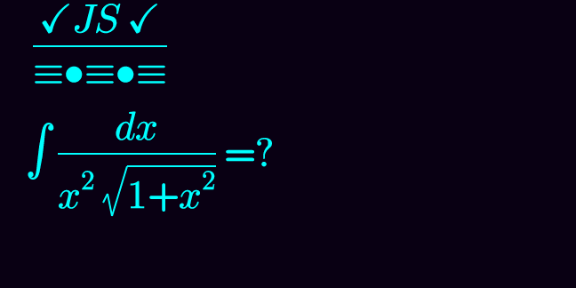
Answered by 1549442205PVT last updated on 24/Aug/20
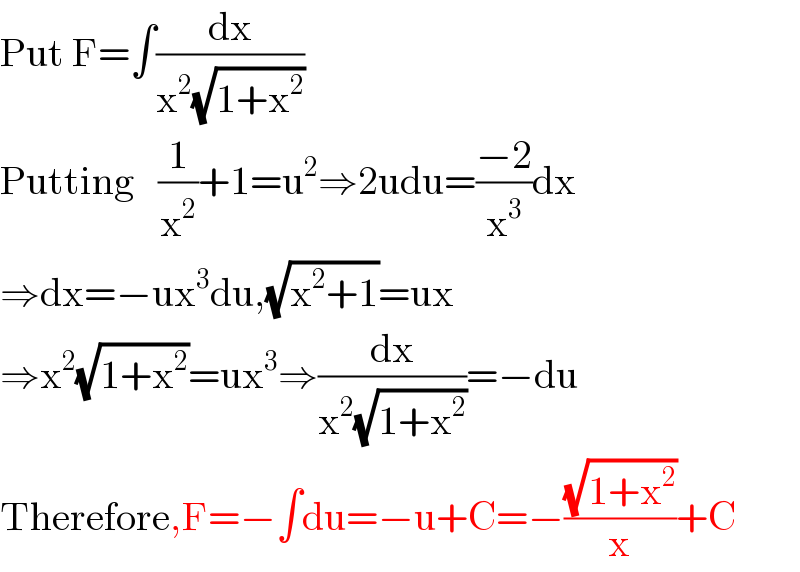
$$\mathrm{Put}\:\mathrm{F}=\int\frac{\mathrm{dx}}{\mathrm{x}^{\mathrm{2}} \sqrt{\mathrm{1}+\mathrm{x}^{\mathrm{2}} }} \\ $$$$\mathrm{Putting}\:\:\:\frac{\mathrm{1}}{\mathrm{x}^{\mathrm{2}} }+\mathrm{1}=\mathrm{u}^{\mathrm{2}} \Rightarrow\mathrm{2udu}=\frac{−\mathrm{2}}{\mathrm{x}^{\mathrm{3}} }\mathrm{dx} \\ $$$$\Rightarrow\mathrm{dx}=−\mathrm{ux}^{\mathrm{3}} \mathrm{du},\sqrt{\mathrm{x}^{\mathrm{2}} +\mathrm{1}}=\mathrm{ux} \\ $$$$\Rightarrow\mathrm{x}^{\mathrm{2}} \sqrt{\mathrm{1}+\mathrm{x}^{\mathrm{2}} }=\mathrm{ux}^{\mathrm{3}} \Rightarrow\frac{\mathrm{dx}}{\mathrm{x}^{\mathrm{2}} \sqrt{\mathrm{1}+\mathrm{x}^{\mathrm{2}} }}=−\mathrm{du} \\ $$$$\mathrm{Therefore},\mathrm{F}=−\int\mathrm{du}=−\mathrm{u}+\mathrm{C}=−\frac{\sqrt{\mathrm{1}+\mathrm{x}^{\mathrm{2}} }}{\mathrm{x}}+\mathrm{C} \\ $$
Answered by $@y@m last updated on 24/Aug/20
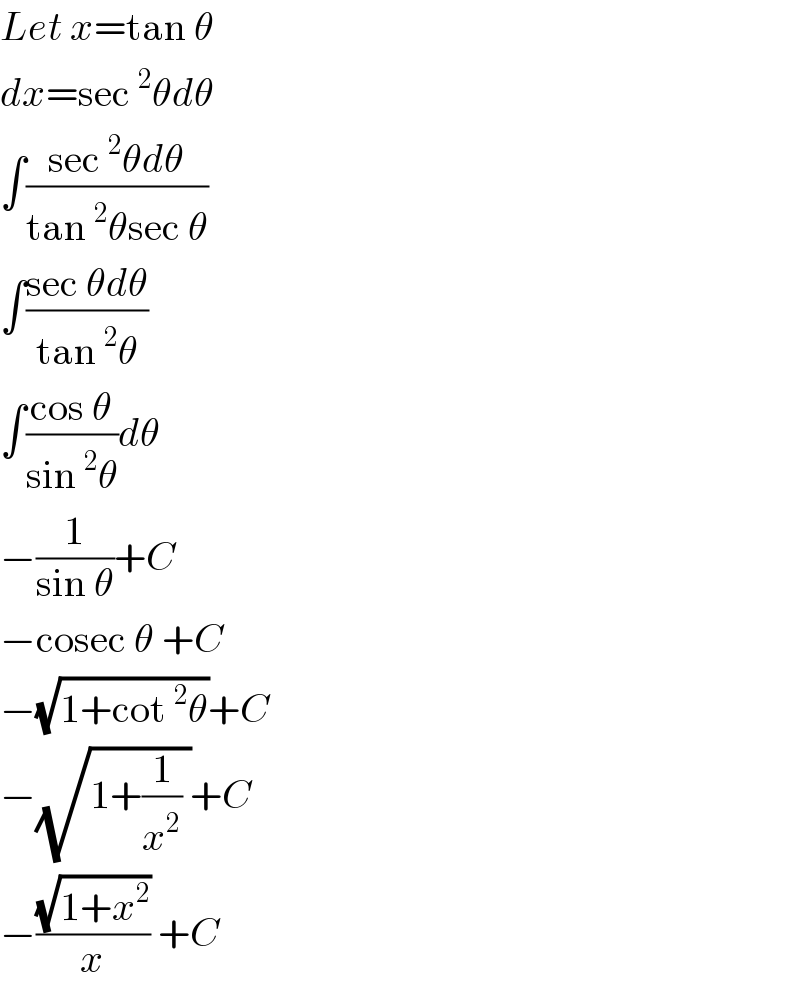
$${Let}\:{x}=\mathrm{tan}\:\theta \\ $$$${dx}=\mathrm{sec}\:^{\mathrm{2}} \theta{d}\theta \\ $$$$\int\frac{\mathrm{sec}\:^{\mathrm{2}} \theta{d}\theta}{\mathrm{tan}\:^{\mathrm{2}} \theta\mathrm{sec}\:\theta} \\ $$$$\int\frac{\mathrm{sec}\:\theta{d}\theta}{\mathrm{tan}\:^{\mathrm{2}} \theta} \\ $$$$\int\frac{\mathrm{cos}\:\theta}{\mathrm{sin}\:^{\mathrm{2}} \theta}{d}\theta \\ $$$$−\frac{\mathrm{1}}{\mathrm{sin}\:\theta}+{C} \\ $$$$−\mathrm{cosec}\:\theta\:+{C} \\ $$$$−\sqrt{\mathrm{1}+\mathrm{cot}\:^{\mathrm{2}} \theta}+{C} \\ $$$$−\sqrt{\mathrm{1}+\frac{\mathrm{1}}{{x}^{\mathrm{2}} }\:}+{C} \\ $$$$−\frac{\sqrt{\mathrm{1}+{x}^{\mathrm{2}} }}{{x}}\:+{C} \\ $$
Answered by bobhans last updated on 24/Aug/20
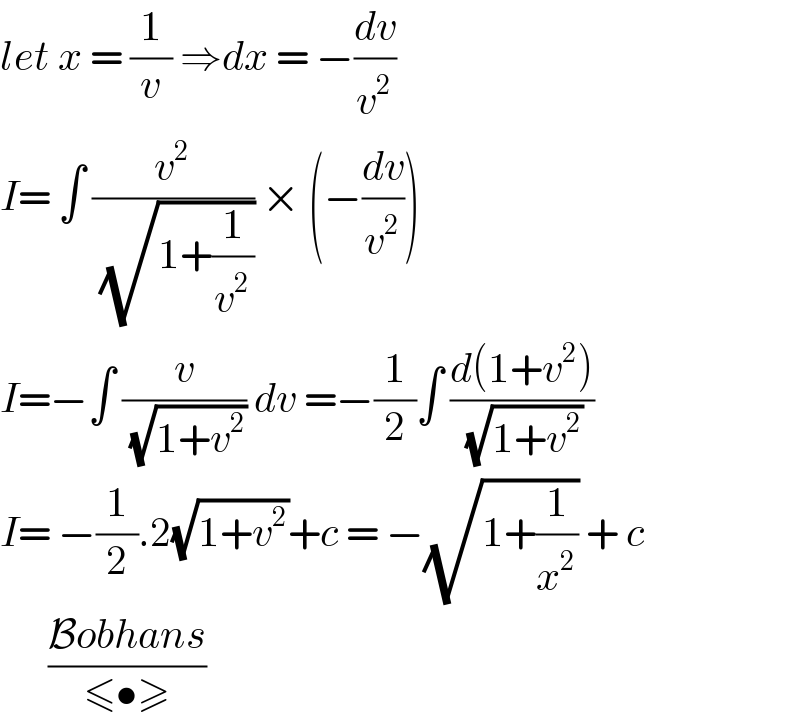
$${let}\:{x}\:=\:\frac{\mathrm{1}}{{v}}\:\Rightarrow{dx}\:=\:−\frac{{dv}}{{v}^{\mathrm{2}} } \\ $$$${I}=\:\int\:\frac{{v}^{\mathrm{2}} }{\:\sqrt{\mathrm{1}+\frac{\mathrm{1}}{{v}^{\mathrm{2}} }}}\:×\:\left(−\frac{{dv}}{{v}^{\mathrm{2}} }\right) \\ $$$${I}=−\int\:\frac{{v}}{\:\sqrt{\mathrm{1}+{v}^{\mathrm{2}} }}\:{dv}\:=−\frac{\mathrm{1}}{\mathrm{2}}\int\:\frac{{d}\left(\mathrm{1}+{v}^{\mathrm{2}} \right)}{\:\sqrt{\mathrm{1}+{v}^{\mathrm{2}} }} \\ $$$${I}=\:−\frac{\mathrm{1}}{\mathrm{2}}.\mathrm{2}\sqrt{\mathrm{1}+{v}^{\mathrm{2}} }+{c}\:=\:−\sqrt{\mathrm{1}+\frac{\mathrm{1}}{{x}^{\mathrm{2}} }}\:+\:{c} \\ $$$$\:\:\:\:\:\:\frac{\mathcal{B}{obhans}}{\leqslant\bullet\geqslant} \\ $$
Answered by mathmax by abdo last updated on 24/Aug/20
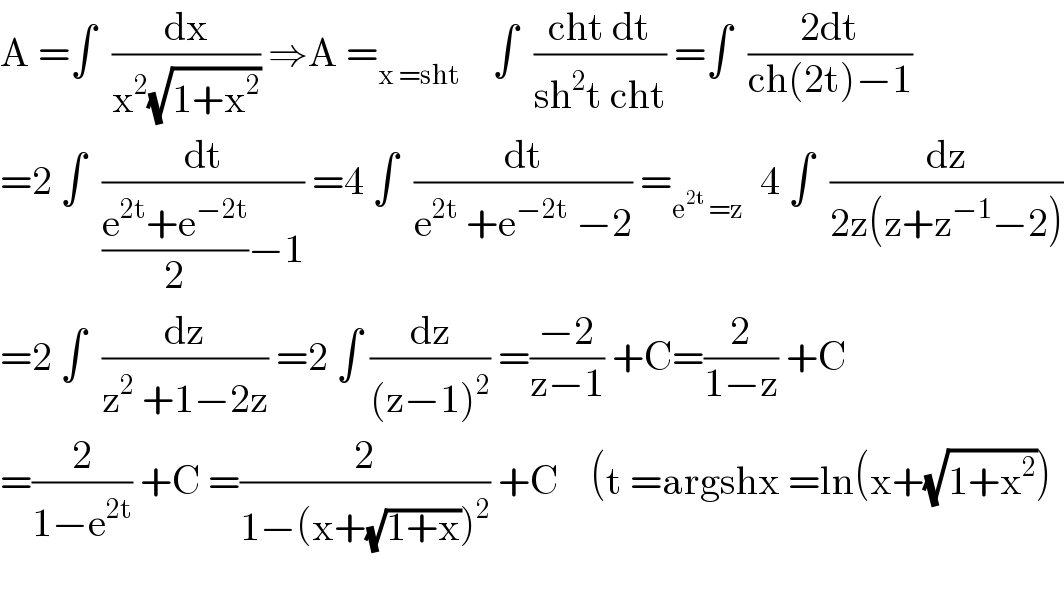
$$\mathrm{A}\:=\int\:\:\frac{\mathrm{dx}}{\mathrm{x}^{\mathrm{2}} \sqrt{\mathrm{1}+\mathrm{x}^{\mathrm{2}} }}\:\Rightarrow\mathrm{A}\:=_{\mathrm{x}\:=\mathrm{sht}} \:\:\:\:\int\:\:\frac{\mathrm{cht}\:\mathrm{dt}}{\mathrm{sh}^{\mathrm{2}} \mathrm{t}\:\mathrm{cht}}\:=\int\:\:\frac{\mathrm{2dt}}{\mathrm{ch}\left(\mathrm{2t}\right)−\mathrm{1}} \\ $$$$=\mathrm{2}\:\int\:\:\frac{\mathrm{dt}}{\frac{\mathrm{e}^{\mathrm{2t}} +\mathrm{e}^{−\mathrm{2t}} }{\mathrm{2}}−\mathrm{1}}\:=\mathrm{4}\:\int\:\:\frac{\mathrm{dt}}{\mathrm{e}^{\mathrm{2t}} \:+\mathrm{e}^{−\mathrm{2t}} \:−\mathrm{2}}\:=_{\mathrm{e}^{\mathrm{2t}} \:=\mathrm{z}} \:\:\mathrm{4}\:\int\:\:\frac{\mathrm{dz}}{\mathrm{2z}\left(\mathrm{z}+\mathrm{z}^{−\mathrm{1}} −\mathrm{2}\right)} \\ $$$$=\mathrm{2}\:\int\:\:\frac{\mathrm{dz}}{\mathrm{z}^{\mathrm{2}} \:+\mathrm{1}−\mathrm{2z}}\:=\mathrm{2}\:\int\:\frac{\mathrm{dz}}{\left(\mathrm{z}−\mathrm{1}\right)^{\mathrm{2}} }\:=\frac{−\mathrm{2}}{\mathrm{z}−\mathrm{1}}\:+\mathrm{C}=\frac{\mathrm{2}}{\mathrm{1}−\mathrm{z}}\:+\mathrm{C} \\ $$$$=\frac{\mathrm{2}}{\mathrm{1}−\mathrm{e}^{\mathrm{2t}} }\:+\mathrm{C}\:=\frac{\mathrm{2}}{\mathrm{1}−\left(\mathrm{x}+\sqrt{\mathrm{1}+\mathrm{x}}\right)^{\mathrm{2}} }\:+\mathrm{C}\:\:\:\:\left(\mathrm{t}\:=\mathrm{argshx}\:=\mathrm{ln}\left(\mathrm{x}+\sqrt{\mathrm{1}+\mathrm{x}^{\mathrm{2}} }\right)\right. \\ $$$$\: \\ $$
